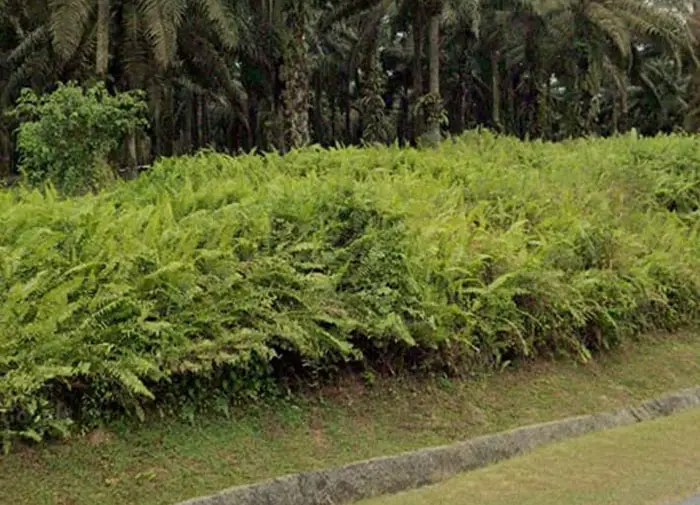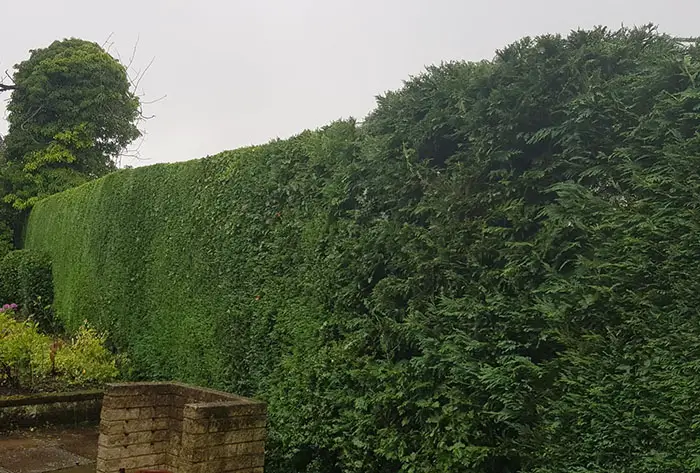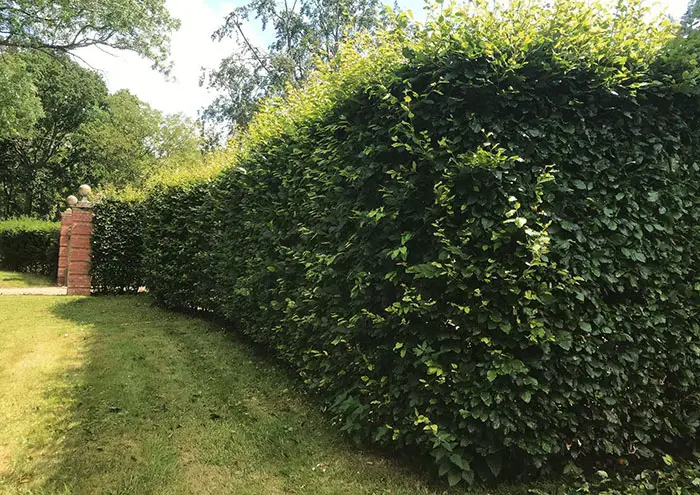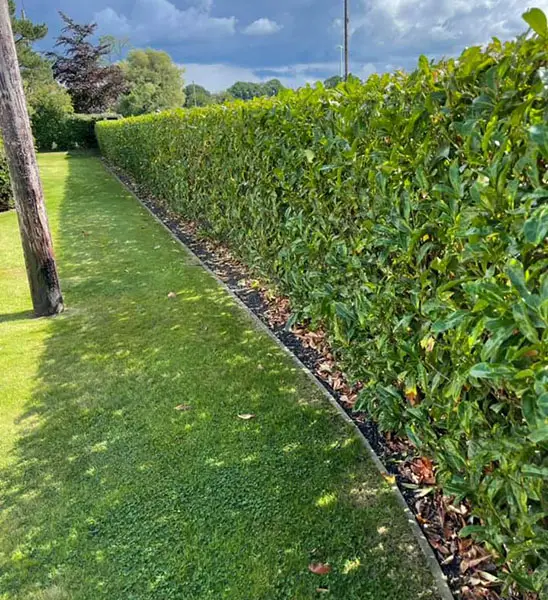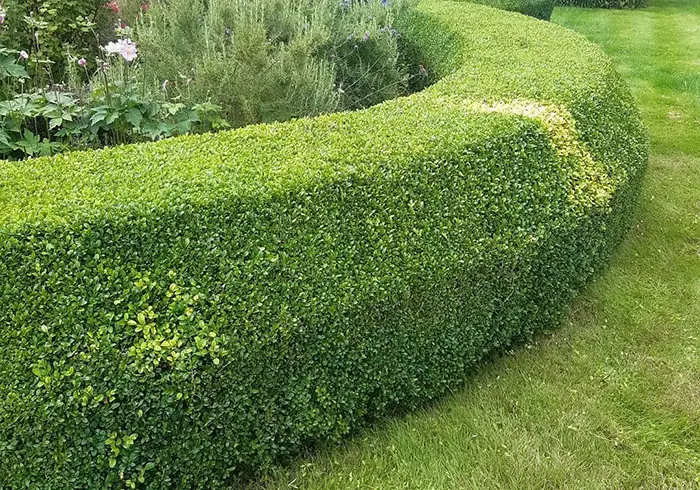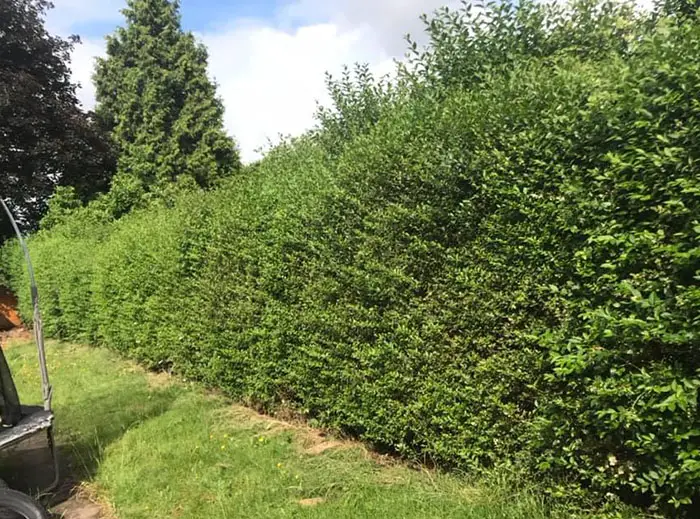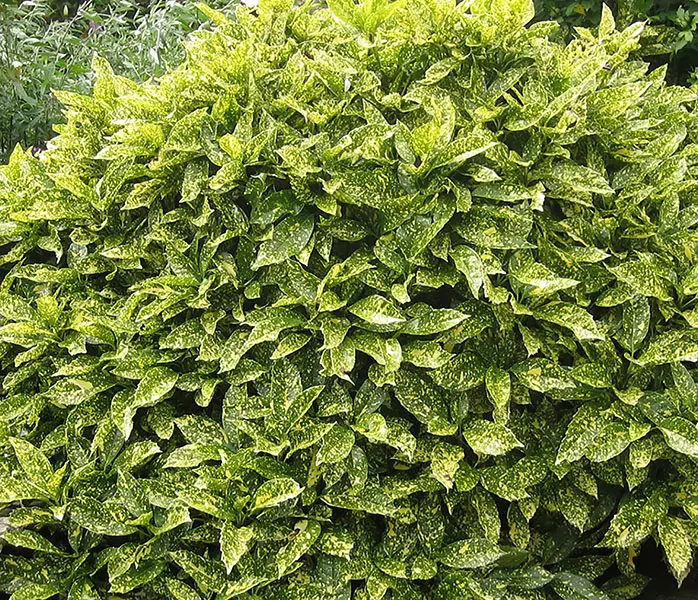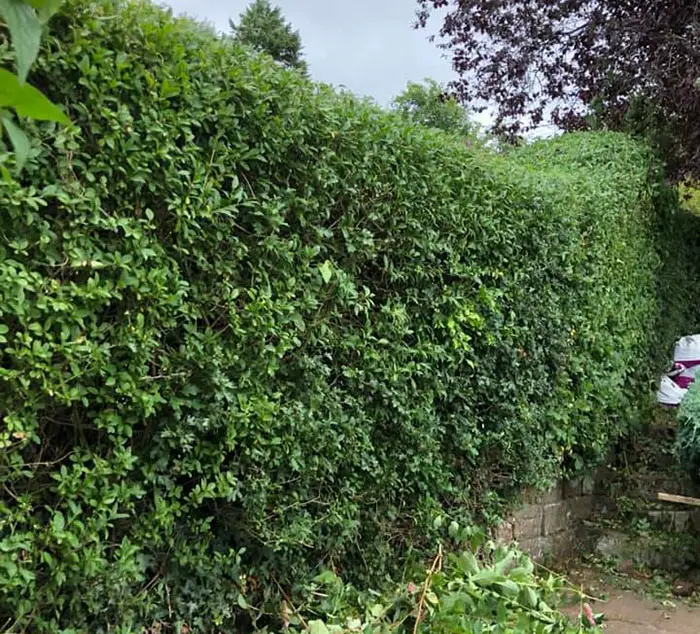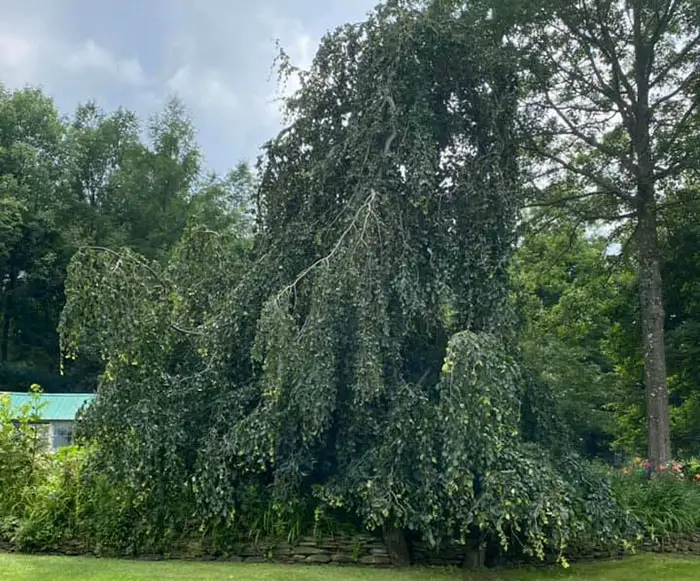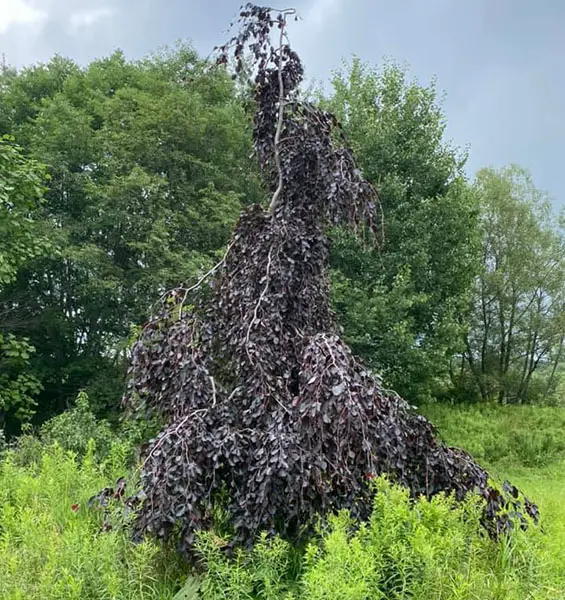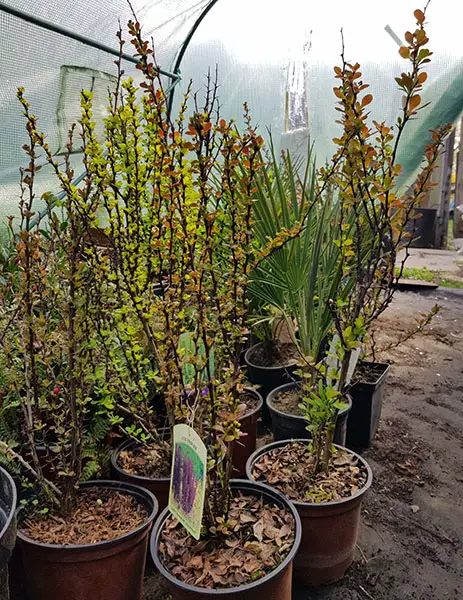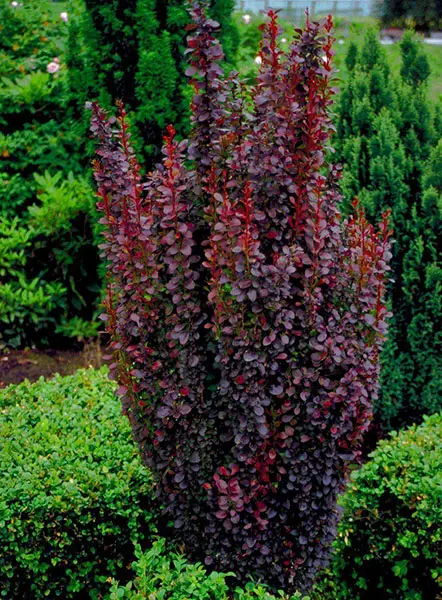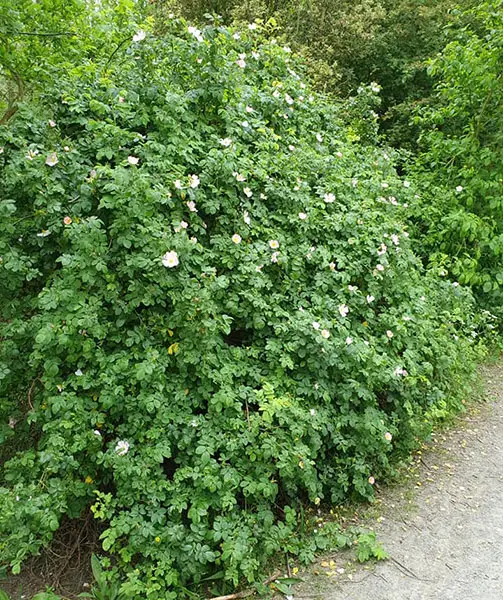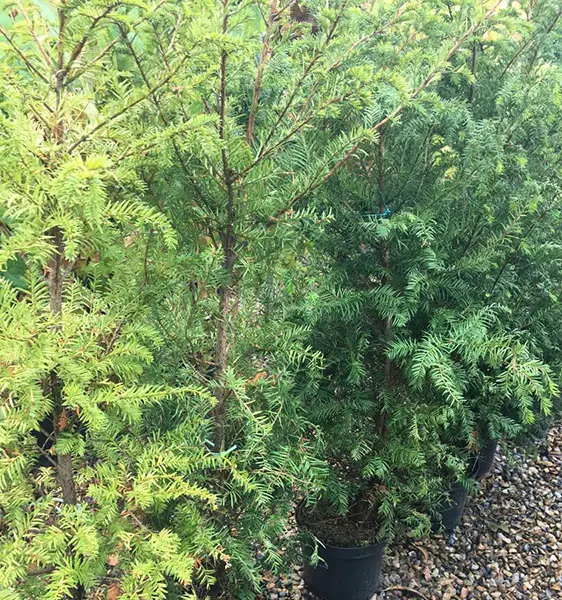When you first move into a new garden, the first thing you may want to do is plan what kind of boundaries you’re going to have.
Obviously, you can have fencing or trellis if you love this kind of stuff. The other option is to look at different types of hedging.
Over the years, we have put in lots of different types of hedging. You can make most trees and shrubs into a hedge.
We will look at some of the most common hedges you can have if you consider having a hedge in your garden.
Hedges can be evergreen, semi-evergreen, or deciduous. As a general rule, evergreens should be planted in early autumn, and you should plant deciduous hedges in mid-autumn to late winter.
Hedging plants can be purchased as bare-root, root ball, or pot-grown.
What Types of Hedging Plants Are Available?
First of you need to decide whether you are going to create a formal or informal hedge. A formal hedge is neatly pruned once a year all through. Many gardeners choose to prune their hedge twice a year, once in Spring and then again in Mid-Summer, to keep their hedge looking neat all year round.
A formal hedge is basically one that can be left to grow wild and can incorporate many varieties of hedging plants and usually requires less maintenance and only needs to be pruned if you want to control the height.
It would be best to decide whether you want to create an evergreen hedge that keeps its leaves through the winter or a deciduous hedge that is the opposite. It drops its leaves for the winter.
The advantage of an evergreen hedge is that it is all ways nearly impossible to see through regardless of the time of year, but often there is a lot more choice if you are willing to consider a deciduous hedge.
Best Times To Plant a Hedge
The best time to plant a hedge is from October to February. The reason for this is that evergreen and deciduous hedging plants go into dormancy for the winter. The cool, moist weather is often ahead, giving the plants winter and early spring to settle before the summer.
Another advantage of planting a hedge in October is that bare-rooted plants are often available from local Nurseries and are cheaper than pot-grown hedging plants.
There is no disadvantage to using bare-rooted plants as this is often how large potted hedging plants started. The only difference is potted plants are normally planted in the pots for over a year, so they are well-rooted.
This is not to say all hedging plants started off being bare-rooted as hedging plants are also grown from plugs and cutting straight from pots as well.
One important point I would like to point out is if you plan to plant a Leylandii hedge, you will struggle to find these bare-root plants, and if you find some bare roots be very careful. The reason for this is they don’t usually survive being dug up, meaning that if you purchase 20 Leylandii Trees, you would be lucky if 10 survived. So be warned, state clear of bare-rooted Leylandii.
Ideal Bare rooted plants include Laurels, Berberis, Quickthorn, Hawthorn, Privet, and Beech.
Finally, all though the best time to plant a hedge is October. You can plant hedging plants all year round by buying pot-grown plants, which will also do well but will need watering regularly until established.
Different Types of Hedging Plants Are Explained!
Leylandii Hedging (Cupressocyparis)
Leylandii Hedging is one of the most popular hedging plants in the US and UK. They can be seen in many gardens across the country and is available in Gold (Golden Leylandii) and Green (Green Leylandii).
Leylandii Hedging makes a dense evergreen hedge that grows approximately 2-3ft a year and can be planted any time of the year. Leylandii is ideal for hedges from around 4ft to virtually any size you require, as Leylandii can reach heights of 30ft+ tall.
When purchasing Leylandii, make sure they are pot grown and not bare rooted as they don’t survive. They are typically available from 30cm (12″) to 7-8ft (84″-96″ tall.
This hedge gets a bad reputation because it’s notoriously involved in neighborhood disputes where people have let the hedge grow way too tall, which casts a big shadow.
It also dries the soil underneath so you can’t grow anything on the ground.
However, if you can take good care of Leyland Cyprus, it’s actually an excellent hedge that you can plant in your garden.
The plants are very good at absorbing air pollution. So if you live by a busy road, it’s one of the best hedges that can help you get rid of emissions. so it’s good to use in that
Some people put it at the shared driveway because it can act as a windbreaker when the wind comes off the open farmland. It also helps provide privacy for the homeowners as people drive past they can’t see directly into the property.
Beech
Beech makes a lovely hedge as it got beautiful color in the spring. It also has lovely autumnal colors in the autumn. It will grow about 30cm to 60 cm in a year, and it can literally grow to about 1 meter to 5 meters tall. The establishment of this plant is quite slow.
It will hold on to the old leaves until the new ones come through. So it means you do have some screening until the new ones come through. However, it wasn’t really providing the privacy that you needed.
Laurel Hedging (Prunus laurocerasus Rotundifolia)
Prunus laurocerasus Rotundifolia, commonly known as laurel hedging, is a vigorous shrub with dark glossy green leaves, making an evergreen dense hedge of all sizes.
It produces modest white flowers in spring and red berries in autumn, but both are insignificant, and really it is chosen for its vibrant foliage. Its growth rate is relatively fast at approx 30/60cm, making it a very economical way to achieve a good height of the evergreen hedge.
It should be trimmed to shape in spring or autumn. Laurel is hardy and easy to grow, including dense shade, but is not the most suitable choice for seaside gardens or very alkaline soil. Like other Laurels, the leaves and berries are harmful if eaten. You can purchase Laurel hedging plants bare-rooted from October to early March.
Box Hedge (Buxus Sempervirens)
Box Plants, also known as Buxus Sempervirens, is the perfect plant for low hedges or separators between paths. Buxus Sempervirens has lush green leaves and is a slow-growing plant with an average growth rate of approximately 10-15cm per year, and it should be trimmed in late spring with hands shears for the perfect trim.
It is suitable for most locations and even in the shade where other plants fail and are suitable for most soil types. It is ideal for all-year-round color as it is evergreen. Box plants are usually sold in pots.
One of the nice things about box hedging is it’s a nice compact, low-growing hedge. Roses can look quite ugly at the bottom, especially in winter. So by planting box hedging, it can help to hide the ugly part of the roses.
Box hedge can create a big problem if you plant them into wet soil that doesn’t drain very well. It would be best if you grew them with sandy soil.
To take good care of box hedging, you need to feed them regularly and cut them whenever they are dry. You need to prune the plant from time to time and clear up all the leaves to prevent the plants from getting diseases.
Privet Hedge (Ligustrum Ovalifolium)
Green Privet is an evergreen/semi-evergreen shrub meaning that it is generally evergreen but may lose some of its leaves in hard winters and put new growth in Spring straight back on again.
It has green leaves and forms a very bushy hedge. It grows at a rate of 1-2ft a year and should be trimmed a couple of times during the summer to encourage the formation of a dense hedge. It will grow well virtually anywhere except waterlogged sites.
Spotted Laurel (Aucuba Japonica)
Spotted Laurel or Aucuba, as it’s also known, is an evergreen hedge with glossy dark green leaves with yellow spots and bright red berries from late summer to early spring.
Spotted Laurels give color throughout the year and are ideal for a formal evergreen hedge. Spotted laurels grow at a rate of 1ft a year, making them slightly slow-growing than the common laurel.
It should be trimmed to shape in late summer. Spotted Laurel is easy to grow and grow well in most soils, sun, or partial shade. We recommend planting at about 18inch to 2ft apart for a dense hedge.
Hawthorn (Crataegus Monogyna)
The Hawthorn (Crataegus Monogyna) is a fast-growing, thorny native deciduous hedge with dark glossy green leaves.
In spring, clusters of prominent scented white flowers burst into the leaf within a few days of the initial buds appearing, followed by glossy red haws in autumn, which sustain native birds. The leaves are 3,5, or 7 lobed, bright green tinged with red. Prune out old growth after flowering to encourage new stems that will bloom the following year, taking care not to remove flowering stems.
Hawthorn makes an excellent hedge with a long season of interest. Trim between July and March.
Hawthorn is suitable for all soil types and positions. In particular, it grows well in town, coastal, or exposed gardens. It has no serious insect or disease problems. Potential diseases include leaf spot or fireblight. Potential insects include aphids, caterpillars, or gall mites. Only birds will eat the bitter cherries.
Green Beech (Fagus Sylvatica)
Green Beech starts with new golden-green leaves turning to green and then when late Autumn sets into a copper color giving it the well-known name of copper beech. Being really classed as deciduous in Britain, it only really starts to lose its copper leaves in spring when the new green leaves in spring start to grow to push last year’s copper leaves off.
Due to this, nature is also an alternative to an evergreen hedge.
Beech grows at a rate of 1-2ft a year and needs to be trimmed in late summer or early Autumn. It’s suitable for most positions in sun or partial shade and moist soils.
Purple Beech, Cooper Beech (Fagus Sylvatica)
Purple Beech has all the features of Green beech except it has attractive purple leaves. The leaves start purple in spring through to summer and then turn a copper color in winter. Purple Beech is really classed as deciduous. It only really starts to lose its copper leaves in spring when the new purple leaves in spring start to grow to push last year’s copper leaves off.
Due to this nature, it is also a good alternative to an evergreen hedge.
Beech grows at a rate of 1-2ft a year and needs to be trimmed in late summer / early Autumn. It is suitable for most positions in sun or partial shade and moist soils except waterlogged.
Berberis Thunbergii ‘Harlequin’
Berberis Thunbergii ‘Harlequin’ is an unusual compact deciduous shrub that only grows to approx 100cm tall and is ideal for creating smaller hedges. It has purple mottled with pink/white blotches on its leaves. It produces yellow flowers in the spring, followed by bright red berries in autumn. Berberis grows approx 12″ (30cm) a year.
Berberis ‘Harlequin’ will grow well in semi-shade as well as full sun and prefers well-drained soil.
Berberis Thunbergii is a fast-growing shrub ideal for hedges and forms a very prickly hedge that is hardy and grows well in virtually any soil, and is ready to grow. Berberis Thunbergii has bright green leaves throughout spring and summer before losing its leaves for the winter.
Berberis is best pruned soon after flowering to enable the growth to grow in time for the following season.
Purple Berberis Thunbergii
Berberis Thunbergii is a fast-growing shrub ideal for hedging. Berberis forms a very prickly hardy hedge, grows well in virtually any soil, and is really easy to grow. Berberis Thunbergii has bright red leaves throughout spring and summer before losing its leaves for the winter.
Berberis is best pruned soon after flowering to enable the growth to grow in time for the following season. Berberis can be purchased bare rooted from October and is available at most Nurseries. If you can’t get hold of any bare-rooted Berberis, you can normally purchase pot-grown ones relatively cheap.
Dog Rose Hedge (Rosa Canina)
The common name for Rosa Canina is “Dog Rose,” which is a native rose and is ideal for a mixed hedge with its burst of scented pink or white flowers in May and June, followed by red rose hips. Dog Rose (also known as Wild Rose or Wild Briar) is very prickly and with a scrambling habit, so it can help form an impenetrable barrier. It is very fast growing.
Dog Rose will grow well in any well-drained moist soil in the sun or shade.
English Yew Hedge Plants (Taxus baccata)
This is also a slowly growing hedge plant. It will grow up to 1 foot a year.
If you want it to grow steadily, you don’t cut the main stem of the plant. Once you cut them in the stem, it becomes a slow-growing hedge. If you leave the main stem, you can cut the sides but leave them in the stem until it grows to the height that you want.
If you have an old hedge or an area that dies, you can cut right into the old wood, and it will regenerate. So if you’ve got an ancient hedge, it’s best to have a “three-year approach” where you top it on one side, and then you top it on the other side on the third year.
From doing that, you can regenerate a horrible-looking hedge into something really nice.
It is a very hardy hedge. It provides good food and shelter for animals. It does have some little red berries on it.
Due to its very dark green color could look very oppressive if you plant too much of it. You can try to plant something lighter, and it can work well with Yew hedges.
Other Plants Ideal for hedging include the following:
- Alder Hedging Plant (Alnus Glutinosa)
- Ash Hedge (Fraxinus Excelsior)
- Bamboo (Phyllostachys)
- Bird Cherry Hedge (Prunus Padus
- Blackthorn Hedge (Prunus Spinosa)
- Cotoneaster franchetii Hedge
- Cotoneaster Horizontalis Hedge
- Cotoneaster Lacteus Hedge
- Crab Apple Hedge (Malus Sylvestris)
- Dogwood Hedges (Cornus – several varieties)
- Elder Hedge (Sambucus Nigra)
- Golden Elder Hedge (Sambucus Nigra Aurea)
- Escallonia Hedge
- Euonymus fortunei “Emerald n Gold” Hedge
- Euonymus fortunei “Emerald Gaiety” Hedge
- Euonymus japonicus “Ovatus Aureum” Hedge
- Field Maple Hedge (Acer Campestre)
- Flowering Currant Hedge (Ribes Sanguineum)
- Forsythia Hedge
- Gorse hedging (Ulex europaeus)
- Griselinia Littoralis Hedge
- Griselinia Dixon’s Cream Hedge
- Guelder Rose Hedge (Viburnum Opulus)
- Hazel Hedge (Corylus Avallana)
- Holly English Hedge (Ilex Aquifolium)
- Hornbeam Hedge (Carpinus Betulus)
- Hypericum Hedge (St John’s Wort)
- June Berry Hedge (Amelanchier Lamarkii)
- Laurel Hedge – Compact (Prunus Laurocerasus Otto Luyken)
- Laurel Hedge – Bay Laurel (Laurus Nobilis)
- English Lavender Hedge (Lavandula angustifolia)
- Lavender Hidcote Hedge (Lavandula angustifolia Hidcote)
- French Lavender Hedge (Lavandula Stoechas)
- Lonicera Hedge (Lonicera pileata)
- Lonicera Hedge (Lonicera nitida)
- Lonicera Nitida “Baggessen’s Gold” Hedge
- Mexican Orange Blossom (Choisya ternata and Choisya ternata Sundance) Hedge
- Monterey Cyprus Hedge “Goldcrest” (Cupressus macrocarpa)
- Oleaster Hedge (Elaeagnus x ebbingei)
- Oleaster Limelight Hedge (Elaeagnus x ebbingei Limelight)
- Oleaster Gilt Edge Hedge (Elaeagnus x ebbingei Gilt Edge)
- Osmanthus burkwoodii
- Photinia Red Robin Hedge (Photinia x fraseri)
- Potentilla Hedge
- Golden Privet Hedge (Ligustrum Ovalifolium Aureum)
- Japanese Privet Hedge (Ligustrum Japonica)
- Prunus x cisterna Hedge (Purple Leaf Sand Cherry)
- Pyracantha (many varieties available)
- Rosemary Hedge (Rosmarinus Officinalis)
- Sea Buckthorn Hedge (Hippophae Rhamnoides)
- Skimmia (Skimmia Japonica Rubella)
- Spindle (Euonymus Europaeus)
- Viburnum Tinus Hedge
- Western Red Cedar Hedge (Thuja plicata)
- Willow Hedge (Salix Capraea)
- Wild Cherry Hedge (Prunus Avium)
- Weigela (Weigela Florida Variegata)

